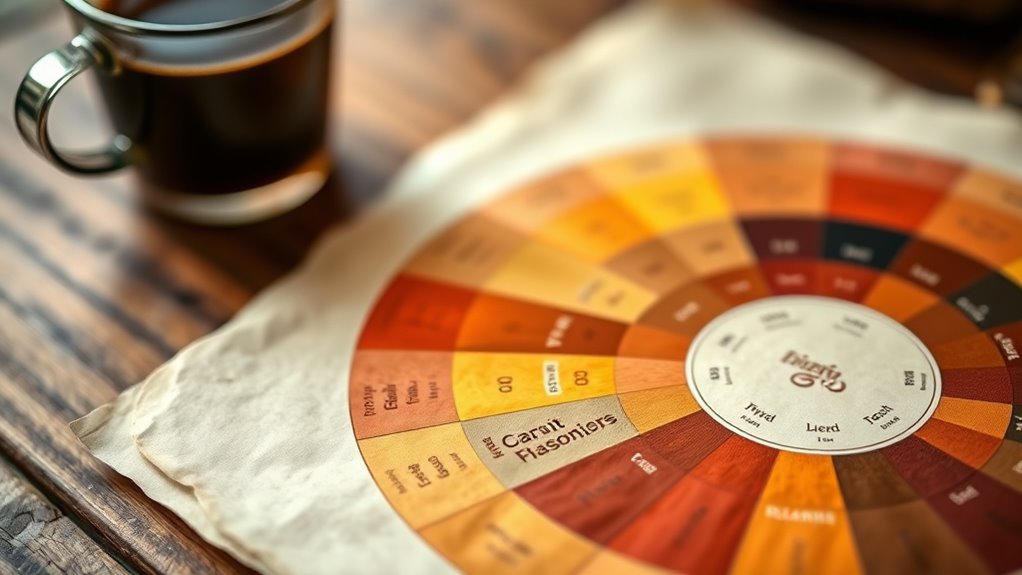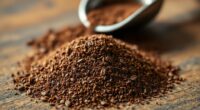A coffee flavor wheel is a visual tool that helps you identify and describe the wide range of coffee aromas and tastes. It organizes flavors from broad categories like fruity, spicy, or floral down to specific notes such as lemon, cinnamon, or jasmine. By using the wheel, you can communicate flavor profiles clearly and consistently. To understand how it works and how to use it effectively, keep exploring further details.
Key Takeaways
- The coffee flavor wheel organizes taste notes hierarchically, from broad categories to specific descriptors, aiding detailed sensory analysis.
- Developed by industry organizations, it standardizes flavor terminology and enhances communication among coffee professionals.
- Color coding on the wheel links flavor categories to visual cues, improving quick recognition and recall of specific notes.
- It helps tasters identify subtle differences in flavor profiles, improving accuracy during sensory evaluation.
- The wheel serves as a visual and linguistic tool to facilitate consistent and precise description of coffee flavors.

Have you ever wondered how coffee experts identify and describe the complex flavors in your cup? The answer lies in the use of a coffee flavor wheel, a visual tool that organizes flavors from broad categories in the center to more specific notes on the outer edge. This hierarchical structure helps professional tasters conduct sensory analysis with precision.
By categorizing flavors into main groups like fruit, spice, or floral, and then narrowing down to detailed descriptors such as lemon, cinnamon, or jasmine, the wheel enables a systematic approach to flavor recognition. This structure simplifies the process of tasting notes, making it easier to communicate complex flavor profiles clearly and consistently.
Categorizing flavors simplifies tasting notes and enhances clear, consistent communication of complex coffee profiles.
The coffee flavor wheel is more than just a colorful diagram; it’s a standardized tool developed through extensive research by organizations such as the Specialty Coffee Association and World Coffee Research. Its purpose is to create a common language for describing coffee’s sensory attributes, ensuring consistency across the industry.
When professional tasters analyze a brew, they rely on the flavor wheel to identify specific attributes, comparing what they taste to the predefined descriptors. This process improves their ability to distinguish subtle differences and nuances, leading to more accurate and detailed sensory analysis.
Color coding is an integral part of the flavor wheel. It visually links specific flavor notes with colors, aiding quick recognition and recall. For example, the color red might indicate berry flavors, while green could represent vegetal or grassy notes. This visual cue helps tasters quickly associate flavors with familiar images, streamlining their flavor recognition process.
The 2016 version of the wheel, a product of three years of dedicated research, is considered the most all-encompassing and industry-standard reference available today. It reflects ongoing efforts to refine flavor categories and descriptors, ensuring they remain relevant and useful for both novice and expert tasters. Understanding the structure of the flavor wheel helps improve sensory analysis and communication within the coffee industry.
Frequently Asked Questions
How to Use the Coffee Flavor Wheel?
To use the coffee flavor wheel, start at the center with broad categories like fruity or nutty. Then, work outward, narrowing down to specific flavors by comparing what you taste with the color-coded sections.
Use the reference notes on the cards to help identify and confirm flavors. Click on the wheel for detailed descriptions, and stop whenever you feel confident, exploring more details as needed for a richer tasting experience.
What Are the 4 Coffee Flavor Profiles?
You’re asking about the four main coffee flavor profiles. They are fruity, nutty, chocolate, and spicy.
Fruity notes include berries and citrus, often from specific regions.
Nutty flavors like almond and hazelnut are common in medium roasts.
Chocolate profiles range from milk to dark chocolate, influenced by roast level.
Spicy flavors, such as cinnamon and pepper, come from particular regions or processing methods.
These profiles help you identify and enjoy different coffee tastes.
How to Understand Coffee Flavors?
To understand coffee flavors, start by tasting different brews and noting your initial impressions. Focus on broad categories like fruity, nutty, or spicy.
Use sensory references and compare flavors to familiar foods or scents to sharpen your palate. Practice regularly, take notes, and calibrate your senses.
Over time, you’ll better recognize subtle nuances and describe the complex flavors that make each coffee unique.
How Do You Judge Coffee Taste?
When judging coffee taste, you focus on aroma, flavor, aftertaste, body, acidity, and balance.
You use systematic sensory analysis, taking notes at different stages to stay consistent.
Comparing multiple coffees side-by-side sharpens your perception of subtle differences.
Calibration with reference samples helps you stay objective.
You rely on your senses, paying close attention to each aspect, to accurately assess the coffee’s overall quality and unique profile.
Conclusion
By familiarizing yourself with coffee flavor wheels, you’ll better identify and appreciate the complex tastes in your favorite brews. They serve as a helpful guide, making it easier to explore new coffees and deepen your sensory experience. Keep practicing, and soon you’ll confidently describe flavors like a true connoisseur. Enjoy the journey of discovering all the nuances that make each cup unique. Cheers to elevating your coffee enjoyment with this simple but powerful tool!









